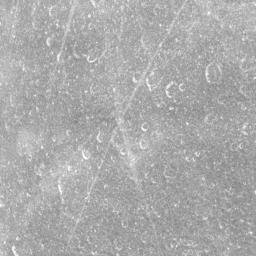
|
Crisscrossing Rhea
- Click the image above for a larger view
- Full-Res JPEG (1016 x 1016) (176.4 kB)
- Full-Res TIFF (1016 x 1016) (1.0 MB)
Caption:
Thin lineaments cross back and forth on the surface of Saturn's moon Rhea in this equatorial view.
These lines can be seen intersecting craters on Rhea (1528 kilometers, 949 miles across). This view is centered on terrain at 0 degrees north latitude, 165 degrees west longitude.
See PIA08871 for an earlier, false-color view that includes surface features such as these.
The image was taken in visible light with the Cassini spacecraft narrow-angle camera on Jan. 11, 2011. The view was acquired at a distance of approximately 41,000 kilometers (25,000 miles) from Rhea and at a Sun-Rhea-spacecraft, or phase, angle of 15 degrees. Image scale is 238 meters (781 feet) per pixel.
Background Info:
The Cassini-Huygens mission is a cooperative project of NASA, the European Space Agency and the Italian Space Agency. The Jet Propulsion Laboratory, a division of the California Institute of Technology in Pasadena, manages the mission for NASA's Science Mission Directorate, Washington, D.C. The Cassini orbiter and its two onboard cameras were designed, developed and assembled at JPL. The imaging operations center is based at the Space Science Institute in Boulder, Colo.
For more information about the Cassini-Huygens mission visit http://saturn.jpl.nasa.gov/ . The Cassini imaging team homepage is at http://ciclops.org .
Cataloging Keywords:
| Name | Value | Additional Values |
|---|---|---|
| Target | Rhea | |
| System | Saturn | |
| Target Type | Satellite | |
| Mission | Cassini-Huygens | |
| Instrument Host | Cassini Orbiter | |
| Host Type | Orbiter | |
| Instrument | Imaging Science Subsystem (ISS) | |
| Detector | Narrow Angle Camera | |
| Extra Keywords | Crater, Grayscale, Visual | |
| Acquisition Date | ||
| Release Date | 2011-05-30 | |
| Date in Caption | 2011-01-11 | |
| Image Credit | NASA/JPL/Space Science Institute | |
| Source | photojournal.jpl.nasa.gov/catalog/PIA12768 | |
| Identifier | PIA12768 | |
